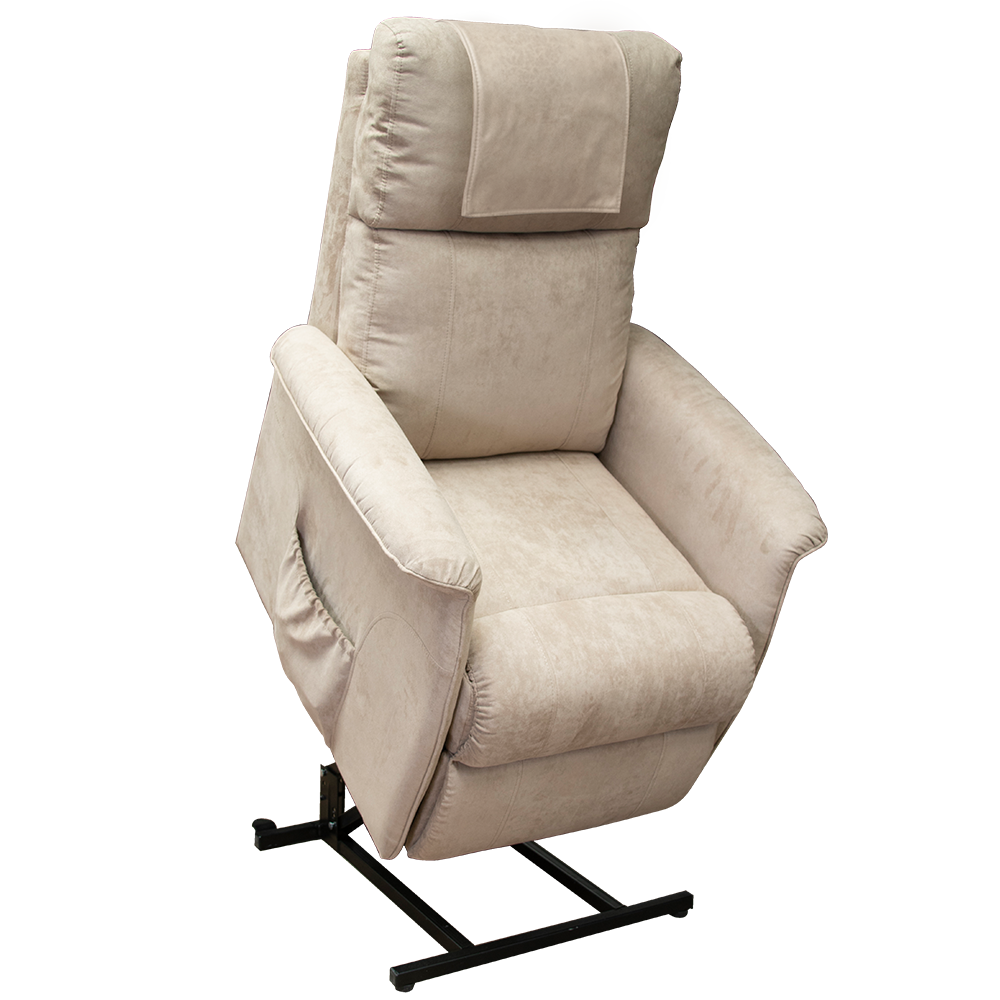Buyers guide to Lift & Recline Chairs
Buyer’s Guide To Lift And Recliner Chairs
A step-by-step guide to choosing a lift and recliner chair
What is a lift and recline chair?
A lift chair looks very similar to a standard recliner and works in much the same way by allowing the user to recline for comfort (or perhaps a quick afternoon nap). The key difference is that a lift chair not only reclines, but also provides support when going from a seated to standing position. Rather than having to lift yourself – which can cause strain to the shoulders, arms and hips – an electric lift chair gently stands you up, reducing fatigue and possible injury.
For carers, an electric lift chair can make caring for your loved one easier. Back injuries associated with lifting someone are common in carers. However, a lift chair can help to prevent injury by assisting with the transfer of the user from one position to another.
Is a lift chair right for you?
A lift chair may be ideal for people who have difficulty getting out of a seated position without assistance. Because the lift mechanism does much of the work of getting you to a standing  position, there is less strain on the muscle, which can lower the risk of injury or fatigue.
position, there is less strain on the muscle, which can lower the risk of injury or fatigue.
A lift chair also offers therapeutic benefits for people with a range of medical conditions – such as arthritis, poor circulation and back pain – by allowing the user to find a comfortable position, whether that’s seated or fully reclined.
The myriad seating positions can also help people who spend a lot of time sitting as the chair can help to reduce the risk of pressure sores, improve circulation and provide optimum support for specific activities.
What to consider
As with any other mobility aid, it’s important that you have the ability and awareness to operate your lift chair safely. A lift chair can seem relatively easy to operate, however, it’s essential the user has the cognition to operate the controls and get themselves from a standing to seated position without assistance.
lift chair safely. A lift chair can seem relatively easy to operate, however, it’s essential the user has the cognition to operate the controls and get themselves from a standing to seated position without assistance.
A good first stop is to chat with your occupational therapist about whether a lift chair is right for you. Because a lift chair takes on much of the work that our muscles normally do when we go from sitting to standing (and the other way round), there is a risk these muscles could weaken even further. Your occupational therapist can help by giving you specific exercises, such as leg raises, to strengthen the muscles.
Single motor or dual motor operation :
Single motor chairs have just the one operating panel that controls both the back recline and leg rest. There are fewer positions available, but they can be easier to operate due to the single control panel, and they are often less expensive.
Dual motor lift chairs have independent controls for the backrest and leg rest, offering a wider range of seating positions, which is ideal if you have difficulty finding a comfortable position.
Finally, space-saving recliner options are designed to be placed closer to the wall and take up less space than standard chairs when in full recline mode. These can be ideal for both seniors who live at home but don't have a lot of space, as well as those who live in a nursing home and are restricted by the size of their room.
Lift chair size :
Lift and recline chairs should be fitted to the user, based on height and weight. The seat of your lift chair should be wide enough to accommodate your hips while still allowing your arms to rest comfortably on the arm rests.
You should be able to sit comfortably with your feet resting on the floor and your legs at a 90 degree angle when in the standard seat position. Look for a depth adjustable seat for personalised comfort and positioning that can be adjusted over time.
 Comfort levels :
Comfort levels :
It’s likely you’ll spend considerable time in your lift chair, so comfort is important. Adjustable padding will allow you to find the most supportive position and maintain good posture in all positions.
Fabric choice should also be considered. The most common fabrics you’ll find are easy-clean suede or medical-grade upholstery.
Easy-clean suede is soft to touch while offering commercial grade durability and is resistant to mildew, flame retardant and anti-pilling.
Alternately, medical-grade Dartex upholstery provides is preferred if you’ll be spending a lot of time seated. The fabric is designed to reduce the risks of pressure injury by distributing the weight across the surface. The fabric has moisture-permeability properties to ensure the surface remains dry and is antimicrobial to prevent infection.
Lift chair models
Single Motor :
The single motor rise and recline chair is ideal if you need a basic chair for everyday use. With a single motor, the chair will go from standing to seated and reclined with the footrest up. Options may include an emergency battery backup system to ensure the chair still functions in the event of power failure.
 Features to look for:
Features to look for:
- Easy clean fabric to make stain removal simple
- Engineered steel frame for stability
- Adjustable upholstery components for individual comfort
- Backup battery in the event of power failure
Dual Motor :
Dual motor rise and recline chairs offer the widest range of seating positions. The two motors control the recline and foot rests independently, allowing the user to find the most comfortable position for them and relieve the effects of sitting for too long.
Features to look for
- Dual control for both the backrest and footrest, providing numerous seating positions
- Depth adjustable seat for ideal positioning and comfort
- Easy-clean fabric for simple upkeep
- Storage pocket for access to reading glasses and a magazine
- Integrated backup battery in case of power outage
Space Saver :
Space saver lift and recline chairs offer the benefits of a single or dual motor chair while requiring less clearance at the back when in the full recline position. They are ideal if space is limited or you want to maximise the clearance in front of your chair.
 Features to look for:
Features to look for:
- Space-saving recline position allows the chair to be placed close to the wall
- Depth adjustable seat for ideal positioning and comfort
- Easy-clean fabric for simple upkeep
- Storage pocket for easy access to small essentials
- The integrated backup battery in case of a power outage
- Quiet and smooth European designed electronics
- Castors to provide for easy movement
- Shop Our Space Saver Lift Chair
Choosing a lift chair
A lift chair should be chosen specially for the user based on their height, as this is what determines the distance the chair needs to lift off the ground to facilitate a safe exit. Other considerations should be given to the user’s weight and how they intend to use the chair.
Lift chairs generally come in three sizes – small, medium and large – and will also have options to adjust the backrest and padding to your personal preference.
Lift chair size guide :
|
User’s Height |
Under 160 cm |
160cm - 172cm |
175cm - 188cm |
|
Chair Option |
Small |
Medium |
Large |
|
Seat Height |
47cm |
48cm |
51cm |
|
Seat Depth |
69cm |
71.5cm |
74cm |
|
Seat Width |
45cm |
48cm |
50cm |
|
Seat to top of Back |
59cm |
62cm |
67cm
|
Using your lift chair
When you get your lift chair home, you’ll want to ensure you get the most out of it. First, consider  how much space you’ll need around the chair. Ensure you have a clear space in front for you to stand up without tripping. Also, make sure you have adequate clearance behind the chair and the wall when it’s in the full recline position.
how much space you’ll need around the chair. Ensure you have a clear space in front for you to stand up without tripping. Also, make sure you have adequate clearance behind the chair and the wall when it’s in the full recline position.
If you use a walking aid or wheelchair to move around, clear some space so you can keep it next to your chair while you’re seated.And of course to make things more convenient, consider having a small table nearby for things like water or a cup of tea.
Think about how you’ll spend your time when seated. Do you prefer to watch television, in which case angle the chair so you can see the screen without glare. Or perhaps you like to read or knit, so natural light during the day and a good reading lamp are essential to avoid eye strain.
Avoid the power cord being a trip hazard by placing your chair near a power point. If there is no suitable power point an electrician can install one for you.
To enjoy your lift chair for many years check the power cord regularly and keep it away from liquids, pets and children. Inspect the fabric regularly for tears or pulls. To clean your chair, use a mild fabric cleaner and gently dab at the area.
The addition of a chair pad can make clean up easier, especially if spills or incontinence is a concern.
Browse the full range of lift and recliner chairs.












































































